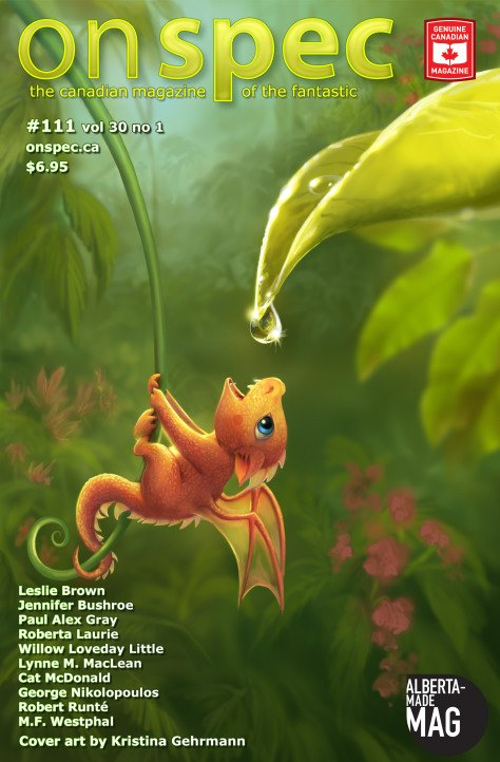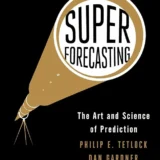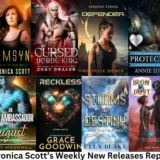
OBIR: Occasional Biased and Ignorant Reviews reflecting this reader’s opinion.

ON SPEC MAGAZINE issue #111, Vol. 30 No. 1.
Publisher: The Copper Pig Writer’s Society. Managing Editor and Art Director: Diane L. Walton.
Issue Designer: Jerry LePage. Poetry Editors: Barry Hammond, and Charlie Crittenden.
Fiction Editors: Barb Galler-Smith, Virginia O’Dine, Madison Pilling, Constantine Kaoukakis, Ann Marston, Laurie Penner, A.J. Wells, Dianne L. Walton, Renee Meloche, Dan Gyoba, Greg Mitchell, and Emily Campbell.
Cover Art by Kristina Gehrmann.
FICTION:
Crimes of the Genome – by M.F. Westphal
Premise:
Jean Green is a transgene living in the Shade, the reborn Lake Agassiz perpetually shrouded by the Solar Panel array arching above. She’s sort of a cop who sometimes helps out the sisters, the Genome worshippers whose trade is gene-slicing. Pity the occupation is rarely legal. And now someone has figured out how to abuse Genome technology beyond anything anyone had ever previously conceived.
Review:
My first question was: what the heck is a Genome? Genes are the sections of DNA that actually do something. A genome, I gather, is that plus all the apparently dormant genes in an organism’s DNA. To know the genome of an individual is to know everything about that individual, including their potential should their genome be combined with another’s.
Those who perform the ritual are known as “Slicers.” I assume this is a variation of “splicer,” in that sections of DNA must be removed, or sliced away, before the splicing or grafting of new material can be done. Given that the standard method appears to be injection, perhaps the slicing is done at a nano-tech level. At any rate, slicing is normally a mutual thing, a mutual donation, in that DNA material is exchanged.
I may be overthinking these details, because they are mere background to the plot. Everyone is allowed one slice in their lifetime as this can be (mostly) controlled and produce useful and even beautiful mutations as well as function as an intimate form of bonding. Trouble is, if done repeatedly, it can be like a cancer, powers and potential mutating into madness, or worse. One slice is legal. Two is bold, flirting with both the law and the possibilities. More than twice pushes the odds toward homicide, and a new case for Jean Green.
This feels very much like Cyberpunk in the tradition of William Gibson. For one thing, you’ve got an off-the-grid population living in a derelict artifact of technology, in this case a shallow lake brought about by the construction of several hydroelectric dams; a lake that receives little daylight, or moonlight for that matter, because of the solar array above; a black, muddy lake whose inhabitants live on rafts and artificial islands. This is a sort of ghetto for non-conformists with uncanny tech knowledge. No wonder the “Sunlighters” view them with alarm.
For another, you’ve got information exchange and manipulation of personalities at a molecular level which goes beyond the brain/computer/electronic intermingling of traditional cyberpunk.
And then you have radical, if logical, extrapolations of this technology’s potential social abuse and exploitation. Slicing is bad enough. But what about virtual slicing? A crime so new no laws prohibiting it have yet been passed. Definitely cyberpunk territory.
And for all that, still an entertaining gumshoe tale harkening back to Sam Spade and his ilk. A nifty cross genre story full of nifty ideas. I like it.
What Little Remains – by Paul Alex Gray
Premise:
Rachel is just a skin worn by a monster made out of smoke and not-light. She lives with another skin named Marcus, also a monster, and the dominant one of the pair. Rachel longs to escape from Marcus. Perhaps a human will help her?
Review:
Shades of Ed Gein, the grave robber and murderer who wore the skins of his victims and later inspired the creation of Norman Bates, Leatherface, and Buffalo Bill in the movies. This story involves monsters who utterly absorb their victims but for the skins which they retain as suitable clothing/disguises to enable them to blend in with humans on the street. Every once and a while they like to fondle their wardrobe because the lingering fears and fading memories attached to the skins give them perverse pleasure. Don’t want to give away too much, so I’ll just conclude by saying this is one creepy “human interest” story.
Blue Crystal Shards – by George Nikolopoulos
Premise:
Ifeyinwa, the heiress to the position of Dibia, servant of the Empress of the African nation Nri, must confront her former lover, the assassin Kumiko, servant of the Empress of Nippon, to break the Japanese monopoly over the magic powers of the blue crystal from Earth’s second Moon. Unfortunately, Kumiko’s loyalty to her sense of honour is infinitely greater than her fond affection for Ifeyinwa. At the very least, a battle of wills must be fought, and failing that, actual combat.
Review:
At first glimpse this story depends heavily on research into Japanese and African mythology, two subjects I know very little about. But given that this takes place in a much altered future where magic is very real and women, being the exclusive wielders of magic, are now the dominant sex in every sphere of human activity, I suspect much of the mythology has been invented to suit the plot and the imagined cultural background. Still, it all hangs together and the setting seems appropriate to the plot. That aspect is well done. Quite convincing, actually.
Does this imply something else is not well done? No. The characters are credible within the cultural background as presented, and the resolution makes sense within the same context. So, a successful story.
My problem is that I remain distant from the story simply because this kind of mythological fantasy is not something I’m interested in. Greek, Roman, Mayan or Aztec mythology-related stories would intrigue me, possibly excite me, but Asian or African themed mythology stories not so much. I’ve studied the four aforementioned belief systems, literally studied them in university courses, but only occasionally read about other belief systems.
To put it another way, I find it hard to identify with either of the two main characters, hard to feel their motivations. Consequently, my critical faculty is not immersed in the story. It’s more like I’m critiquing a scene in a movie. There’s an element of separation involved. This is no reflection on the story, merely an artifact of my ignorance. It’s just not quite my cup of tea. That would be my fault, not the author’s. Fact is I suspect people who love mythological fantasy will love this story.
Cu Chulainu Makes a Tinder Account – by Willow Loveday Little
Premise:
The Hound of Ulster, a legendary Irish Hero not quite fully human, finds it difficult to socialize in modern times.
Review:
An amusing poem suggesting personal habits and attitudes formed thousands of years ago can be a bit of a handicap in coping with change. Yet another reason why being an immortal is not as much fun as it sounds. I thought I had enough troubles being a twentieth-century kinda-guy. Twentieth-century B.C. is even worse, apparently. At least, I assume the Hound dates back at least that far, the reference to Saint Patrick being merely one of the events he witnessed in a very long life.
To sum up, this poem offers a delightful glimpse into the mind of a pagan Irish quasi-deity struggling with some of the same problems I struggle with. Kindred spirits, I figure. Quite enjoyed reading it. Whimsical.
Cold War – by Lynne M. MacLean
Premise:
Ann is an ichthyologist specializing in sharks, barracuda and others we think of as predatory fish (even though all fish feed on living critters). She lost a friend to sharks and is glad to be back in the North West Territories reacquainting herself with a certain long-lived Sturgeon. Trouble is, something very dangerous seems to be displacing resident species, including the local humans.
Review:
A very Canadian story reflecting our growing awareness of the coming competition for the resources of the warming Arctic Ocean and the vague apprehension that, despite our enormous Arctic coastline and myriad Arctic islands, we are going to be ignored by the major players. A nice touch to include a character who can only communicate via selected quotes from Coleridge’s The Rime of the Ancient Mariner. Adds a classic depth to events. Maybe just a tad anthropomorphizing in the treatment of the Sturgeon’s behaviour, but perhaps that can be considered a fantasy element in what is otherwise a brisk, rather precise horror story. Basically, one of those yarns that convinces me my decision not to swim in the ocean, any ocean, is a very good idea. Also provides food for thought regarding the advantages and disadvantages of scientific progress. More and more our relationship with nature is becoming something of a conundrum. This tale points that out rather well.
The Girl Who Loved like Fire and the Blacksmith Who Was Afraid of His Heart
– by Jennifer Bushroe
Premise:
The girl literally has a heart of gold. Too often she gives it to another, only to have it rent and torn. Fortunately, the blacksmith’s apprentice, who only once removed his heart out of a sense of curiosity, has sufficient skill to mend her heart. However, with every subsequent affair the damage is greater and harder to repair.
Review:
A metaphor for the heartbreak many, if not most, women endure in life. Hard to place the role of the apprentice though. The close male friend who is never more than a friend and is always someone a girl can fully reveal her heartache to without being betrayed or belittled? The unrequited love she should have chosen in the first place? Or simply an example of someone who survives moderately well by never giving in to passion?
There is a suggestion that love is futile and not worth pursuing, yet no one has any choice whom their heart embraces and pursues, so futility is our lot regardless. A bit bleak, that. The ending is a resolution of sorts, an adjustment to reality, but not quite what the girl had been dreaming about all her life. But then, life is like that, isn’t it? One thing for sure, dreams always come to an end eventually. This story left me feeling a bit sad.
The Sacred Order of the Guardians of the Last Door – by George Nikolopoulos
Premise:
The most annoying rite imposed on the sacred brethren watching the door is the perpetual vow of silence. Fortunately, a few centuries ago Frederick the Frivolous introduced the art of tap dancing to enable the brethren to communicate in code. Alas, Brother William is a lousy dancer. He’s on the verge of being expelled from the order.
Review:
This is a very funny short story. And, as you might guess, it is revealed what lies beyond the door, and that, too, is quite amusing. Not the most profound story you will ever read, but it will make you smile.
Hospice – by Leslie Brown
Premise:
Li’Lall has been cast out by her clan to die. Such is the customary end for an aged female. But one of the curious Ground Worms the Regent permits in the city, a fur-less, claw-less thing that calls itself human, offers her a chance to spend her last days in a building open to all clan cast-outs. At first Li’Lall is outraged at this violation of clan instinct and tradition, but as she has always possessed an unusual independence of mind, her curiosity prevails and she takes up the human’s offer.
Review:
Contact between humans and aliens is almost always from the human viewpoint. Yet I fondly recall a story, I think from the 1950s, told from a caring Martian’s perspective as he attempts to salvage human society from a post-nuclear-war-ravaged Earth. There is something especially intriguing about investigating human culture and behaviour through alien eyes. This story captures that sense-of-wonder stirring process in a gentle, persistent, yet memorable way.
Granted, there’s a hint of human imperialism in the quiet introduction of civilizing influence on the instinct-driven culture of the natives, but also a clear implication it’s a matter of allowing them to reach their full potential without sacrificing their inherent nature. Every attempt is made to avoid tricking the aliens into imitating humans. Instead, they are being maneuvered into pulling themselves up by their own bootstraps, so to speak. Interference? Yes. But genuinely beneficial, unless you believe all cultures should be frozen in time and never allowed to evolve or progress.
This is an old-fashioned, optimistic piece of speculative fiction. Given the dystopian nature of the real world these days, it is positively refreshing to read. Pleasant and enjoyable, I’d say.
NON-FICTION:
Remembering Dave – Editorial by Diane L. Walton
A brief reminiscence of Dave Duncan, well-known and much beloved Fantasy author who passed away recently. Many of the editors knew him from frequent appearances at ConVersion.
Dave Duncan’s Legacy – by Robert Runte, PhD.
Robert reveals that of Dave Duncan’s 62 published novels (with three more still to come), 60 of them were written after he retired at age 55. Hmm, I’m only 68. Makes me wonder if I have at least one novel hidden inside me.
You might think anyone writing that many Fantasy and SF novels in so few years has got to be a formulaic, hack writer. No sir, the exact opposite. Robert lays down in clear, precise terms why Dave was uniquely brilliant and quite possibly one of the greatest writers the Fantasy genre has ever produced. Robert’s explanation is also a very useful lesson on the attributes and methods Fantasy writers should aim to acquire. Beginning writers take note. Dave Duncan is a superb role model.
For the Sky and the Sea – Author Lynne M. MaClean interview by Roberta Laurie
A very revealing interview with an up-and-coming author, especially interesting for her explanation of what inspired her story Cold War, what influences shaped it, and what it means to her.
History Writes the Best Stories – Artist Kristina Gehrmann Interview by Cat McDonald
Always inspirational to read about the interests and projects of a professional illustrator and artist. All of her work sounds extremely interesting.
Bot and Comic – by Lynne Taylor Fahnestalk
Both superb examples of Lynne’s wry sense of humour.
CONCLUSION:
The usual wide selection of genres and topics presented in stories of exceptional quality which make for interesting and often exhilarating reading. On Spec is always worth checking out. Highly recommended.
Check it out at: < www.onspec.ca >










“(even though all fish feed on living critters)”
Counter-example fish that eat mostly plants include tilapia, mollies, silver dollars, metynnis, pacu, surgeonfish, parrotfish, chinese algae eater, milkfish, young menhaden, various kind of carp.